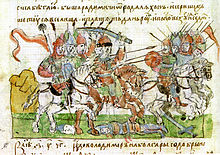Radimichs
Seven-beam temporal jewelry made of bronze or silver represent a specific ethnic trait of the Radimichs of the 9th - 11th centuries.
In 984, the Radimichs tried to break away from the Kievan Rus, but were defeated on the Pischan River by Vladimir the Great's commander Volchiy Khvost ("Wolf's Tail").
They continued living on their land, gradually assimilating with neighboring tribes and peoples and forming the Belarusian nationality.
In the Primary Chronicle, it is recorded that the Radimichs, Vyatichi, and Severians "had the same customs", all lived violent lifestyles, "burned their dead and preserved the ashes in urns set upon posts beside the highways", and they did not enter monogamous marriages but practiced polygamy, specifically polygyny, instead.
[4] However Yefim Karsky spoke out against the theory of the Lechites origin of the Radimichi, showing the independent development of those features of the Belarusian language that bring it closer to the Polish.
[6] Repeated attempts were made to determine the area from which the Radimichi came to Sozh by mapping toponyms with the base rad-.
[9] Georgy Khaburgaev, [ru] believed that the term "radimichi" was formed from the historically earlier name of the Baltic ethnic community, which was Slavicized by the 9th-10th centuries.
[12] This article includes content derived from the Great Soviet Encyclopedia, 1969–1978, which is partially in the public domain.
